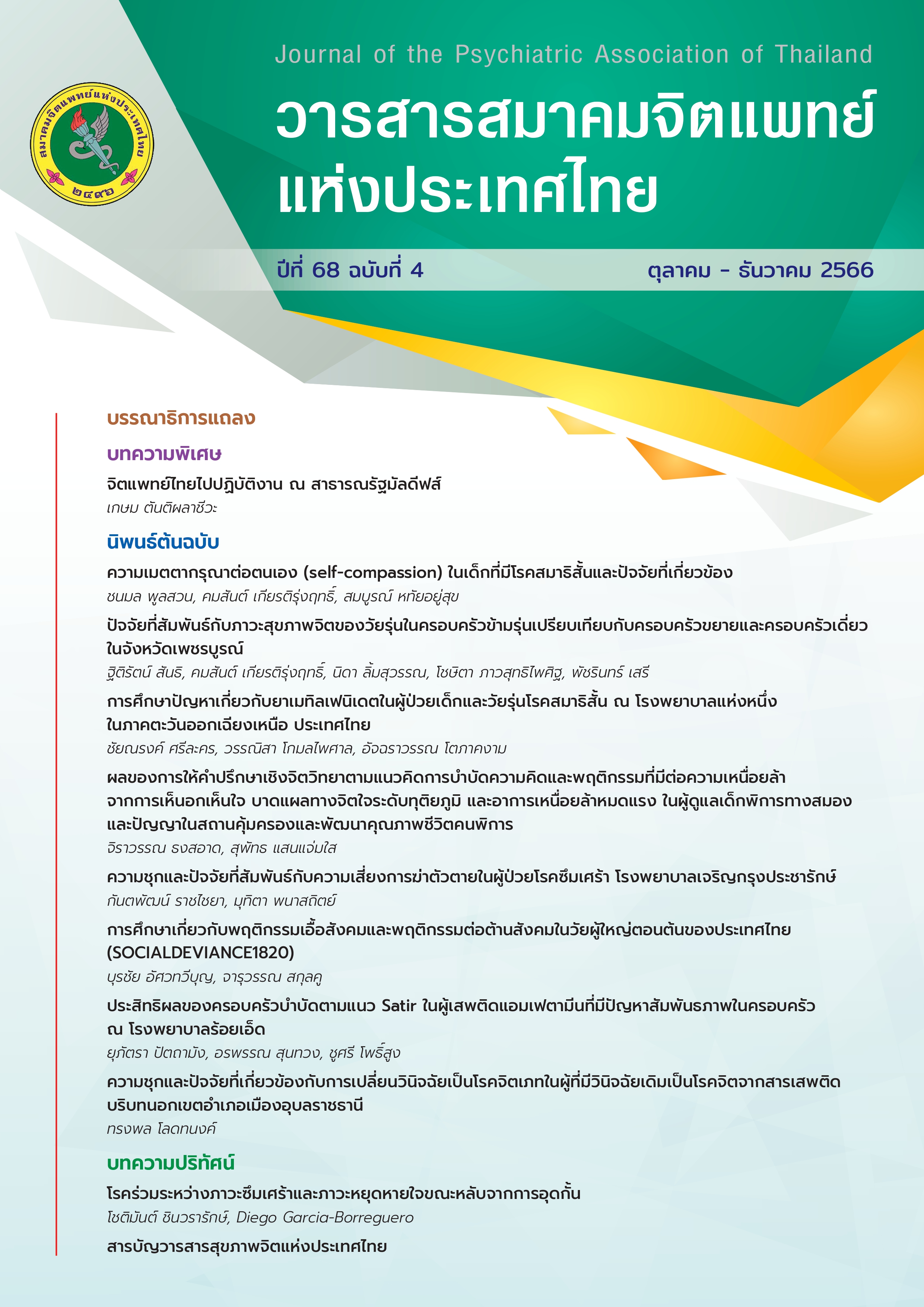Study of Methylphenidate-Related Problems in Children and Adolescents with Attention-Deficit/Hyperactivity Disorder at a Hospital in Northeast Thailand
Main Article Content
Abstract
Objective: To examine the prevalence and details of problems associated with the use of methylphenidate in children and adolescent patients with attention-deficit/hyperactivity disorder (ADHD) at the Northeastern Institute of Child and Adolescent Mental Health (NECAM)
Methods: A cross-sectional study was conducted in ADHD patients aged between 6 to 18, who were undergoing treatment with methylphenidate at the Northeastern Institute of Child and Adolescent Mental Health (NECAM) between October 2022 and January 2023. Methylphenidate-related problems (MRPs) were evaluated using the Pharmaceutical Care Network Europe (PCNE) version 9.1 tool and Naranjo's algorithm. Types and characteristics of problems, causes, resolution methods, and acceptance of problem-solving measures were analyzed in terms of frequency and percentage.
Results: The study included 286 patients with a mean age of 10.5 ± 2.9 years, of whom the majority (85.3%) were male. The median duration since ADHD diagnosis was 2.0 years (interquartile range: 0.8 to 4.1 years), and the median duration of methylphenidate treatment was 1.0 year (interquartile range: 0.4 to 2.9 years). Among the patients, 152 individuals (161 events) encountered MRPs, having a prevalence of 53.1%. The most common problems (56.5%) were safety-related issues, all stemming from adverse drug reactions, whereas 43.5% of the problems were related to treatment effectiveness. The top three adverse drug reactions were decrease in appetite (57.1%), nail biting (7.7%), and insomnia (7.7%). Most of effectiveness-related problems (94.3%) were attributed to patient knowledge and behavior, such as medication underuse, overuse, or lack of understanding about treatment. Both effectiveness and safety problems were primarily resolved at the patient level, with only a small proportion was resolved at professional level (2.5%) and by drug change (1.2%). Overall, the resolution of all issues was widely accepted and acknowledged (100.0%).
Conclusion: This study identified issues related to the use of methylphenidate in children and adolescent patients with ADHD, encompassing both treatment effectiveness and adverse reactions. Effective patient monitoring and collaboration among healthcare professionals, along with comprehensive patient education and communication, are recommended to prevent, detect, and address problems, thereby promoting positive treatment outcomes.
Article Details

This work is licensed under a Creative Commons Attribution-NonCommercial-NoDerivatives 4.0 International License.
Articles submitted for consideration must not have been previously published or accepted for publication in any other journal, and must not be under review by any other journal.
References
American Psychiatric Association. Diagnostic and statistical manual of mental disorders-text revision. 4th ed. Washington, DC: American Psychiatric Association; 2000.
Polanczyk G, de Lima MS, Horta BL, Biederman J, Rohde LA. The worldwide prevalence of ADHD: a systematic review and metaregression analysis. Am J Psychiatry 2007;164(6):942–8.
National Statistical Office. Report on children and adolescents surveyed in 2020. Bangkok; Ministry of Information and Communication Technology, 2021.
Department of Mental Health. Annual report on mental health in 2020 [Internet]. [cited 2022 Apr 1]. Available from: https://dmh.go.th/report/datacenter/hdc/
Wolraich ML, Hagan JF, Allan C, Chan E, Davison D, Earls M, et al. Clinical practice guideline for the diagnosis, evaluation, and treatment of attention-deficit/hyperactivity disorder in children and adolescents. Pediatrics 2019;144(4):1007–22.
Khajehpiri Z, Mahmoudi-Gharaei J, Faghihi T, Karimzadeh I, Khalili H, Mohammadi M. Adverse reactions of methylphenidate in children with attention deficit-hyperactivity disorder: report from a referral center. J Res Pharm Pract 2014;3(4):130–6.
Tobaiqy M, Stewart D, Helms PJ, Williams J, Crum J, Steer C, et al. Parental reporting of adverse drug reactions associated with attention-deficit hyperactivity disorder (ADHD) medications in children attending specialist paediatric clinics in the UK. Drug Saf 2011;34(3):211–9.
Patel MX, David AS. Medication adherence: predictive factors and enhancement strategies. Psychiatry 2007;6(9):357–61.
Gajria K, Lu M, Sikirica V, Greven P, Zhong Y, Qin P, et al. Adherence, persistence, and medication discontinuation in patients with attention-deficit/hyperactivity disorder - a systematic literature review. Neuropsychiatr Dis Treat 2014;10:1543–69.
Foundation Pharmaceutical Care Network Europe. The PCNE classification V 9.1. 2020 [Internet]. 2020 [cited 2020 Nov 8]. Available from: https://www.pcne.org/upload/files/417_PCNE_classification_V9-1_final.pdf
Naranjo CA, Shear NH, Lanctôt KL. Advances in the diagnosis of adverse drug reactions. J Clin Pharmacol 1992;32(10):897–904.
Pimratana W. Associations between caretakers’ attitude, caretakers’ knowledge of attention deficit hyperactivity disorder (ADHD) and child patients’ compliance to take methylphenidate (MPH). Journal of the Psychiatric Association of Thailand 2016;61(1):15–26.
Yamane T. Statistics: an introductory analysis. 3rd ed. New York: Harper and Row; 1973.
Tantipiwattanaskul K. A study of drug related problems in child and adolescent with mental health problem. Journal of Health Science 2019;28(6):986–95.
Hage A, Weymann L, Bliznak L, Marker V, Mechler K, Dittmann RW. Non-adherence to psychotropic medication among adolescents - a systematic review of the literature. Z Kinder Jugendpsychiatr Psychother 2018; 46(1):69-78.
Solmi M, Miola A, Croatto G, Pigato G, Favaro A, Fornaro M, et al. How can we improve antidepressant adherence in the management of depression? A targeted review and 10 clinical recommendations. Braz J Psychiatry 2021;43(2):189–202.
Ninlanon K, Sakulbumrungsil R, Phattanarudee S, Tan-khum T. Factors affecting methylphenidate adherence in children and adolescent with attention deficit hyperactivity disorder. Journal of Mental Health of Thailand 2015;23(1):1–11.
Jumpapan M. The study of prevalence and factors associated with medication nonadherence in child and adolescent psychiatric department, Nakorn Nayok Hospital. Journal of the Psychiatric Association of Thailand 2023;68(1):13–25.
Vucur C, Wirtz DA, Weinhold L, Zipfel M, Schmid M, Schmidt-Wolf IGH, et al. Drug-related problems in head and neck cancer patients identified by repeated medication reviews on consecutive therapy cycles. J Oncol Pharm Pract 2021;27(6):1439–46.


